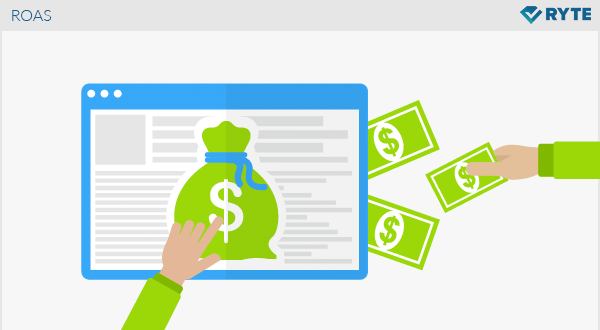ROAS
ROAS is an acronym for "Return on Advertising Spend". It is an important key performance indicator in online marketing. ROAS is based on the principle of return on investment, but shows the actual profit achieved per advertising expense in dollars. While the overall ROI shows the ratio between revenue and cost, ROAS is used to evaluate individual ads and campaigns. In this way, a company can easily determine their profit per advertising measure.
Difference between ROAS and ROI
To calculate the return on investment, the profit margin and the total capital are used, among other things. ROAS, on the other hand, does not take these indicators into account. This means that a negative ROI value can still result in a positive ROAS.
How it works
The ROAS indicator can be used to answer questions regarding the effectiveness of specific advertisement:
- What is the relationship between my expenditure for paid ads and the sales generated with them?
- Do my ads generate conversions?
- Which ads convert well and which ones don’t?
- For which ads should keywords be deleted and for which ads should I increase my spending or CPC?
The ROAS is a suitable tool for such questions, since it shows the profit and advertising expenditure invested in a percentage ratio. The ROAS is calculated as follows.
How to calculate ROAS
This is how you can calculate the ROAS:
ROAS = (profit/advertising costs) * 100
If a company generates a profit of $1000 and the placement of ads amounts to $200, the ROAS would be 500%. The value should be as high as possible, so that the advertising costs represent only a fraction of the profit. Depending on the type and purpose of the project, however, the ROAS may be lower, for example, when launching a new website or branding campaign, where long-term effects are more important than the effectiveness of the ads placed.
However, a high ROAS value does not automatically represent the success of a company. If the product being advertised requires high production costs, the ROAS value may be high, but the actual profit may be low. The extent to which the ROAS indicator is useful and informative depends therefore on the company, the campaign, and its objectives.[1]
Significance for online marketing
In contrast to other key figures in online marketing, which are monetarily independent, the ROAS shows the relationship between profits and advertising costs. The clicks generated by advertising do not say anything about the percentage of the profits that these clicks may have generated. The ROAS, on the other hand, gives an exact ratio and allows marketers to keep an eye on their campaigns, associated expenses, and profits. The ROAS value is particularly useful in the context of a Google Ads strategy where conversions with very different amounts are to be expected.
This requires workable conversion tracking.[2] With Google Ads, the so called "target ROAS" corresponds to the average value of a conversion, which is targeted per euro invested in the advert. ROAS can also be calculated with Facebook advertisements. This would refer to all conversions assigned to the individual Facebook ads achieved via the Facebook Pixel.
ROAS figures can also be transferred to scoreboards to provide decision-makers in management positions with an aid. This is particularly useful when planning future campaigns, but also provides an insight into ROAS figures for past months and years if scoreboards are created regularly. This enables you to react quickly to changes in the effectiveness of individual advertisements and campaigns.[3]
ROAS can also be understood as a tool with which you can control, analyze and optimize the success rate of your advertising measures. The ROAS is more accurate that the conversion rate as an indicator of profit maximization. If the performance of individual advertisements is unsatisfactory, the ROAS can be improved by various measures. By analyzing and comparing the success of different advertising measures with each other, the use of the advertising budget can be optimized and profits increased on the basis of this key figure.
References
- ↑ What is Return On Advertising Spend (ROAS)? brickmarketing.com. Accessed on December 17, 2018
- ↑ Flexible Gebotsstrategien verwenden support.google.com. Accessed on November 13, 2018
- ↑ The Return on Advertising Spend Metric techwyse.com. Accessed on December 17, 2018

